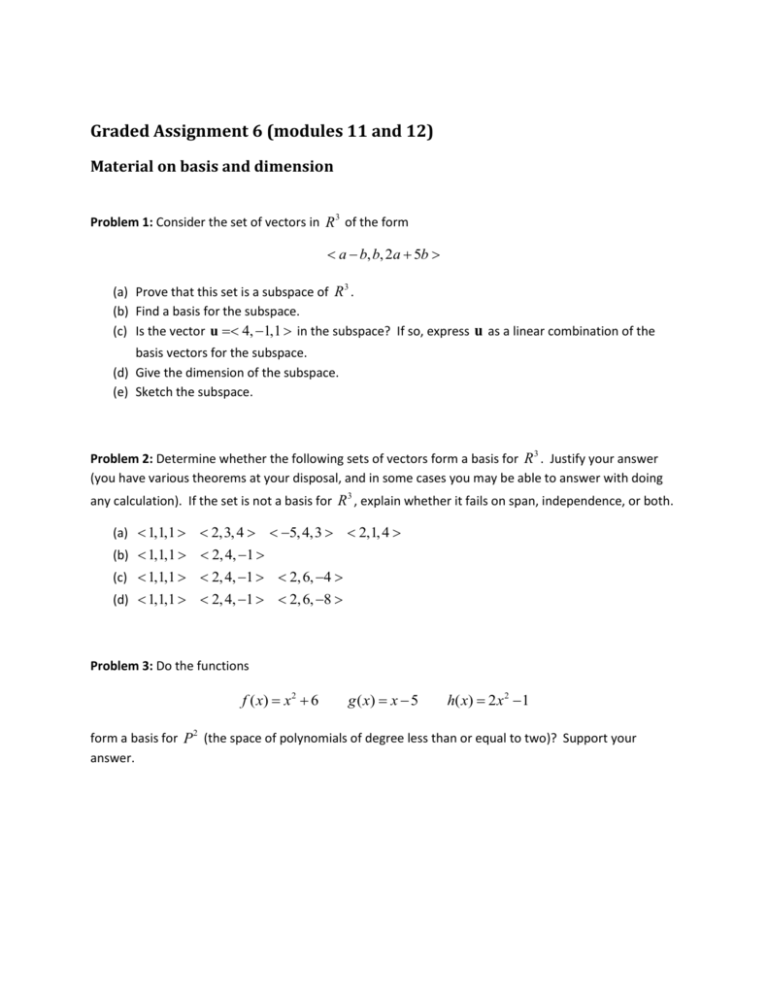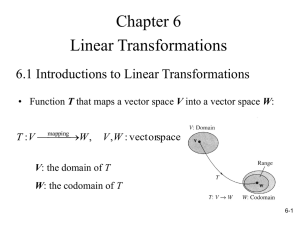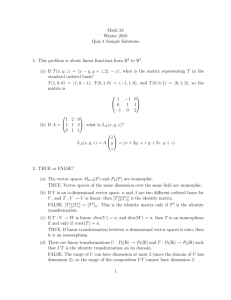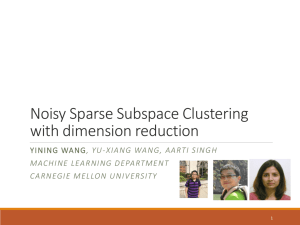Graded Assignment 6 (modules 11 and 12)
advertisement

Graded Assignment 6 (modules 11 and 12) Material on basis and dimension Problem 1: Consider the set of vectors in R 3 of the form a b, b, 2a 5b (a) Prove that this set is a subspace of R 3 . (b) Find a basis for the subspace. (c) Is the vector u 4, 1,1 in the subspace? If so, express u as a linear combination of the basis vectors for the subspace. (d) Give the dimension of the subspace. (e) Sketch the subspace. Problem 2: Determine whether the following sets of vectors form a basis for R 3 . Justify your answer (you have various theorems at your disposal, and in some cases you may be able to answer with doing any calculation). If the set is not a basis for R 3 , explain whether it fails on span, independence, or both. (a) 1,1,1 2,3, 4 5, 4,3 2,1, 4 (b) 1,1,1 2, 4, 1 (c) 1,1,1 2, 4, 1 2, 6, 4 (d) 1,1,1 2, 4, 1 2, 6, 8 Problem 3: Do the functions f ( x) x 2 6 g ( x) x 5 h( x) 2 x 2 1 form a basis for P 2 (the space of polynomials of degree less than or equal to two)? Support your answer. Problem 4: For the matrix 1 3 1 0 3 2 A 1 1 1 3 11 3 5 1 1 9 (a) Give bases for the row and column spaces of A . What are the dimensions of these spaces? (b) What is rank(A)? Problem 5: For each of the given systems of equations, determine if the system has unique/no/infinitely many solutions, and explain why by discussing the rank of the coefficient matrix vs. the rank of the augmented matrix for the system. (a) System 1 3x1 x2 x3 1 2 x1 3x2 x3 1 x2 x3 2 3x1 x2 x3 1 2 x1 3x2 x3 1 (b) System 2 x1 2 x2 3 Linear transformations Problem 6: For each of the transformations given, either (1) prove that it's linear, or (2) give a counterexample showing that it's non-linear. (a) T : R 2 R 3 , T ( x, y ) x y, y 3, 2 x . (b) T : R 2 R 2 , T ( x, y ) 2 x 3 y,5 y x . (c) T : R 3 R 2 , T ( x, y, z ) xz, yz Problem 7: Write the matrix representation of the transformation T : R3 R 2 , T ( x, y, z ) 2 x 3 y z,5z x and find the image of u 1, 0,1 under the transformation. Problem 8: Give the matrix representation of the transformation in the plane T T3 T2 T1 where T1 is a rotation through an angle of 30 degrees. T2 is a reflection across the origin. T3 is a contraction by a scale factor of 1 2 Apply the composite transformation to the unit square. Verify visually that the transformed square has been rotated, reflected, and shrunk as indicated above. Problem 9: Determine the kernel and range for the transformation T : R3 R 2 , T ( x, y, z ) 2 x 3z, y Give a basis for each, and state the dimension. Verify that the rank/nullity theorem holds. Problem 10: Become a computer animator! Here's a picture: Wreck the house. Go ahead, warp it, skew it, flatten it ... to accomplish this, you need to Record the coordinates of all the vertices. Enter them as columns in a matrix. Invent a 2 2 transformation matrix. Make sure it is non-singular. And transform the vertices. (One of the lectures covers how to transform a set of vertices in one operation; be sure to find that) Experiment with a few transformation matrices; see what you get. These don't have to be the rotation/dilation/reflection transformations - you can invent any non-singular matrix and see what it does. Please submit TWO of your favorite transformed houses by including (a) A sketch (you can do this by hand, on graph paper) (b) The SciLab code used to do the transformations (so I can clearly see what you put down for the original vertices, what your transformation matrix is, and what your new vertices are).








